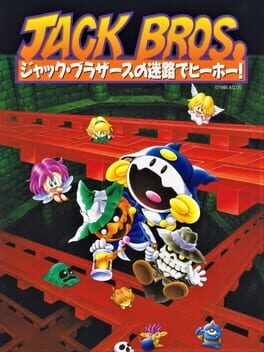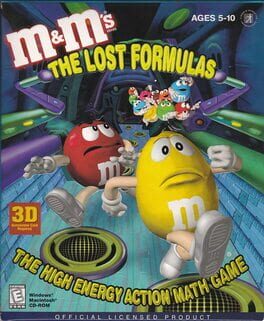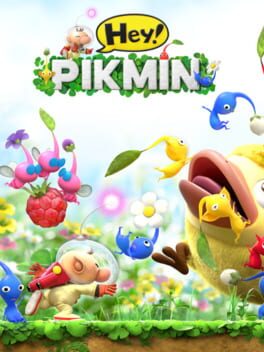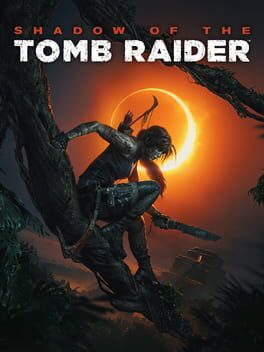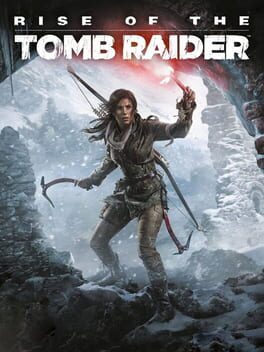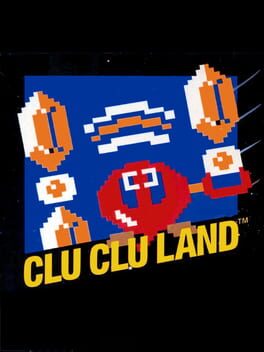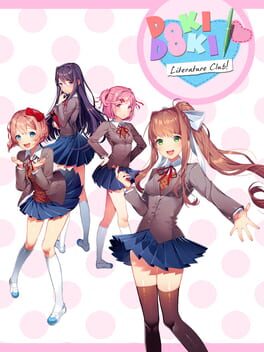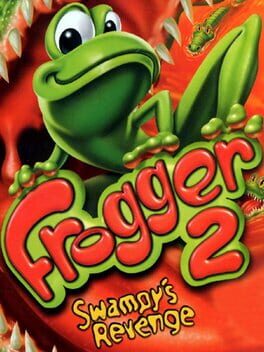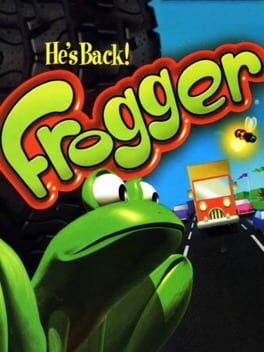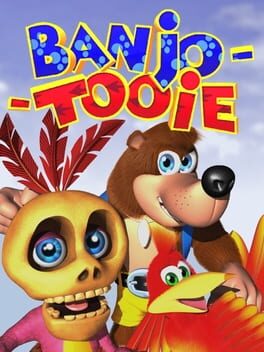MacBlank
1995
Kind of a lost gem from the Virtual Boy! Basically a puzzle shmup, where you're navigating different tiers of mazes, solving lock-and-key puzzles with increasingly more complex enemies the further down you go. The visual perspective makes for (what I'd imagine would be) a fun use of the Virtual Boy's 3D effect. It's bite-sized, which makes it both smartly-designed for the system and a great candidate for a mobile port. A little surprised SEGA hasn't gone for it, honestly.
Given what Shin Megami Tensei has become, it's funny to think that this was the series' introduction in the west. The western marketing makes it pretty unrecognizeable, much as I like the creepy monster designs for the three Jacks in the key art in a vacuum. But in-game, the Jacks, Pixie, and the enemies are clearly the series regular demons you know if you've played any of the SMTs/Personas (well, mostly; Jack Skelton never really caught on). Sort of funny to have this cutesy Halloweeny story end with the Jacks taking one of the SMT regular big bads. I guess it's a bit like one of the scariest dudes in all of Castlevania coming from Kid Dracula?
Given what Shin Megami Tensei has become, it's funny to think that this was the series' introduction in the west. The western marketing makes it pretty unrecognizeable, much as I like the creepy monster designs for the three Jacks in the key art in a vacuum. But in-game, the Jacks, Pixie, and the enemies are clearly the series regular demons you know if you've played any of the SMTs/Personas (well, mostly; Jack Skelton never really caught on). Sort of funny to have this cutesy Halloweeny story end with the Jacks taking one of the SMT regular big bads. I guess it's a bit like one of the scariest dudes in all of Castlevania coming from Kid Dracula?
2009
I don't go for this casual of a game super often (my only other real point of reference is Diner Dash), but I got it in a pack, and it was 2020.
It was all right. Like Diner Dash and its descendants, the mode of the game seems to be ordering and manangement. Being able to queue up quite a few moves and cancel them as needed lends itself to a decent rhythm, though there's a bit of unpredictability with things like crows, bugs, and fruit rot. It's nice that the option to ward off crows (by... slapping them?) is an unrelated input from the growing/harvesting queue, but you really do need to either be on your toes or willing to drop everything to handle bugs/rot.
I know having different customer "archetypes", and leaning on stock stereotypes, is pretty standard for this type of game - Grannies are slow, kids are impatient, etc. It is kinda weird that one of the archetypes here is just "Inuit".
It was all right. Like Diner Dash and its descendants, the mode of the game seems to be ordering and manangement. Being able to queue up quite a few moves and cancel them as needed lends itself to a decent rhythm, though there's a bit of unpredictability with things like crows, bugs, and fruit rot. It's nice that the option to ward off crows (by... slapping them?) is an unrelated input from the growing/harvesting queue, but you really do need to either be on your toes or willing to drop everything to handle bugs/rot.
I know having different customer "archetypes", and leaning on stock stereotypes, is pretty standard for this type of game - Grannies are slow, kids are impatient, etc. It is kinda weird that one of the archetypes here is just "Inuit".
Okay Crash Bandicoot clone, if a bit lightweight. There was a very specific era around the late 90s where you had a lot of these. I didn't have access to Crash back then, so I sort of assumed that this was simply a genre of 3D platformers. You could do better than this, but M&Ms gets some credit for bringing in the original voice actors (J. K. Simmons is kind of a big get for a video game, particularly for this era) and for incorporating some alternate Crash Bandicoot level archetypes in the bonus stages - surfing, vehicles, and chases for two.
I was able to get this in a Scholastic book fair because of the game's main selling point (after the license) - it's an edutainment game! Each of the eight levels are broken up into three stages; while the first and third of these are standard gameplay, the second is always an optional math stage. Basically, you come upon a set of rooms, each with numbers on 'em. You're supposed to jump onto the number that completes the given equation. If you don't, the platform vanishes and you lose a life. You do this for a bit until the game decides you're done.
It's... something. The math stages are always pretty unrelated to the overarching plot of Yellow and Red trying to stop the Minis from wrecking the factory. Math's relevance is never explained, and the levels - which generally follow a clear spatial progression through the game world - always stop dead in their tracks for the mathy stuff. Plus, you can just switch 'em off. I'm not terribly inclined to complain, since it's what let me get the game, but it's a pretty bad teaching tool.
Obviously not really worth seeking out these days, but decent enough.
I was able to get this in a Scholastic book fair because of the game's main selling point (after the license) - it's an edutainment game! Each of the eight levels are broken up into three stages; while the first and third of these are standard gameplay, the second is always an optional math stage. Basically, you come upon a set of rooms, each with numbers on 'em. You're supposed to jump onto the number that completes the given equation. If you don't, the platform vanishes and you lose a life. You do this for a bit until the game decides you're done.
It's... something. The math stages are always pretty unrelated to the overarching plot of Yellow and Red trying to stop the Minis from wrecking the factory. Math's relevance is never explained, and the levels - which generally follow a clear spatial progression through the game world - always stop dead in their tracks for the mathy stuff. Plus, you can just switch 'em off. I'm not terribly inclined to complain, since it's what let me get the game, but it's a pretty bad teaching tool.
Obviously not really worth seeking out these days, but decent enough.
2017
Hey! This sucks.
Alright, that's mean, but I couldn't resist. Unfortunately, it encapsulates my thoughts on this game. This is another game by Arzest, who I best know for bastardizing Yoshi's Island (as "Artoon", originally) and who most people best know for Balan Wonderworld. Insofar as I'm concerned, Arzest understands Pikmin about as well as they understand Yoshi.
Adapting Pikmin to a 2D platformer is an interesting idea. I'm not necessarily opposed to this, much as it reminded me of the ill-fated Chibi-Robo: Zip Lash, because there are a lot of interesting ways Pikmin's puzzle RTS mechanics could adapt into a platformer setting. I'm not fond of Olimar's Smash Bros. interpretation, but Brawl has the start of an idea with the Pikmin Chain - theoretically you can do things with that, Bomb Rock puzzles, elemental affinities, weight and flight, etc etc etc. problem is, Hey! Pikmin rarely goes for any of that. Most puzzles in the game are of the lock-and-key variety; bring X Pikmin [of Y type] here to solve the puzzle. This wouldn't necessarily be a bad thing - lock-and-key puzzles are your bread and butter in video games - except that the game has little interest in iterating upon its own mechanical challenges. By way of example, there are these optional challenge rooms throughout the game. I wasn't really challenged by the first few of these, but I figured the game would ramp up the difficulty once it established what it was going for. But in fact, I found the final challenge room exactly as difficult as the first one had been.
Pikmin is a series I love for its quiet touches and moments. Especially in the first game, everything is so understated: you aren't on a big, bombastic adventure, but rather a fight for survival on a hostile world. Later games step away from this, but there's always a sense of trying to hold onto little things in a bigger universe. The Piklopedia in 2, the team chatter in 3, and I haven't played 4 as of this writing.
Hey! Pikmin doesn't seem to understand this. It has the shape of these ideas with things like Olimar's monster/treasure notes, but it doesn't really get them. It doesn't get Olimar. There's the understanding that Olimar is a salaryman who does everything he can to support his family, but... like, he sounds whiny about it here. The game knows that Olimar should fundamentally misunderstand the Earth treasures he comes across, but then the game lets him understand what humans are (for goodness' sake, he comes across a snowglobe with Santa Claus, and he recognizes that that's what a person looks like. That feels like that breaks so many rules. To say nothing about Donkey Kong Land, specifically, being canon to this game).
Then there are the little skits with the Pikmin. Every so often, you'll be treated to a little scene of the Pikmin doing something cute in the level. I really don't like this. There's an increased emphasis on Pikmin domesticity throughout side material that rubs me the wrong way. They are a hunter-gatherer people who must be accustomed to the hardships of their way of life. I'm fine seeing them as a curious child-like people in the context of something like the Piklopedia treasures, where it's clear that the Pikmin are leveraging the free time they have under Olimar's leadership and exploring the elements of their world with their newly-afforded freetime. Not like how it's done here, when in the middle of every level, there are scenes - sometimes multiple per level - of the Pikmin tripping or pushing each other around or waving at each other or SOMEthing like that. Stuff clearly engineered to make the player go "awwwww lookit em". It's such a blatant, cloying attempt to turn the Pikmin into Minions that I just got annoyed seeing the little guys do their thing (this coming from someone who's generally tolerant of the Minions).
Two things I like to this game, or at least one I like and one I am at an understanding with. To start with the latter, I don't love any of the bosses, and in point of fact I rather hate how over-the-top dramatic the final boss is (they've been hinting at him the whole game!!!!! Guys this is the ultimate pimpkin fight!!!!!!!!!!!) - but I do think the first boss fight, against an ordinary Red Bulborb, is an interesting concession. There was no real way to communicate the feeling of fighting an enemy like a Bulborb in the normal gameplay of a 2D platformer, so as weird as it sounds, I'm okay with it as an early game boss. Makes for a decent enough chiasm with Emperor Bulblax being one of the late game bosses, too.
The one level I really like is "The Lonely Tower", which comes about halfway into the game. As a change of pace, Olimar starts the level completely alone. You don't get any Pikmin until a decent way through the level, after you've already had to do some platforming to scale the titular tower. It's the one time I feel like the game gets Pikmin's tone, and I honestly think that'd be fascinating design to explore in the context of a mainline Pikmin game. As essential as the Pikmin mechanics are to series identity, there's something to be said for the moods a player can experience by their absence.
If more of Hey! Pikmin had this level of thought, it'd have the potential to be an understated entry in such an understated series. As it is? Stay away unless you're a die-hard fan, and even then, don't expect much.
Alright, that's mean, but I couldn't resist. Unfortunately, it encapsulates my thoughts on this game. This is another game by Arzest, who I best know for bastardizing Yoshi's Island (as "Artoon", originally) and who most people best know for Balan Wonderworld. Insofar as I'm concerned, Arzest understands Pikmin about as well as they understand Yoshi.
Adapting Pikmin to a 2D platformer is an interesting idea. I'm not necessarily opposed to this, much as it reminded me of the ill-fated Chibi-Robo: Zip Lash, because there are a lot of interesting ways Pikmin's puzzle RTS mechanics could adapt into a platformer setting. I'm not fond of Olimar's Smash Bros. interpretation, but Brawl has the start of an idea with the Pikmin Chain - theoretically you can do things with that, Bomb Rock puzzles, elemental affinities, weight and flight, etc etc etc. problem is, Hey! Pikmin rarely goes for any of that. Most puzzles in the game are of the lock-and-key variety; bring X Pikmin [of Y type] here to solve the puzzle. This wouldn't necessarily be a bad thing - lock-and-key puzzles are your bread and butter in video games - except that the game has little interest in iterating upon its own mechanical challenges. By way of example, there are these optional challenge rooms throughout the game. I wasn't really challenged by the first few of these, but I figured the game would ramp up the difficulty once it established what it was going for. But in fact, I found the final challenge room exactly as difficult as the first one had been.
Pikmin is a series I love for its quiet touches and moments. Especially in the first game, everything is so understated: you aren't on a big, bombastic adventure, but rather a fight for survival on a hostile world. Later games step away from this, but there's always a sense of trying to hold onto little things in a bigger universe. The Piklopedia in 2, the team chatter in 3, and I haven't played 4 as of this writing.
Hey! Pikmin doesn't seem to understand this. It has the shape of these ideas with things like Olimar's monster/treasure notes, but it doesn't really get them. It doesn't get Olimar. There's the understanding that Olimar is a salaryman who does everything he can to support his family, but... like, he sounds whiny about it here. The game knows that Olimar should fundamentally misunderstand the Earth treasures he comes across, but then the game lets him understand what humans are (for goodness' sake, he comes across a snowglobe with Santa Claus, and he recognizes that that's what a person looks like. That feels like that breaks so many rules. To say nothing about Donkey Kong Land, specifically, being canon to this game).
Then there are the little skits with the Pikmin. Every so often, you'll be treated to a little scene of the Pikmin doing something cute in the level. I really don't like this. There's an increased emphasis on Pikmin domesticity throughout side material that rubs me the wrong way. They are a hunter-gatherer people who must be accustomed to the hardships of their way of life. I'm fine seeing them as a curious child-like people in the context of something like the Piklopedia treasures, where it's clear that the Pikmin are leveraging the free time they have under Olimar's leadership and exploring the elements of their world with their newly-afforded freetime. Not like how it's done here, when in the middle of every level, there are scenes - sometimes multiple per level - of the Pikmin tripping or pushing each other around or waving at each other or SOMEthing like that. Stuff clearly engineered to make the player go "awwwww lookit em". It's such a blatant, cloying attempt to turn the Pikmin into Minions that I just got annoyed seeing the little guys do their thing (this coming from someone who's generally tolerant of the Minions).
Two things I like to this game, or at least one I like and one I am at an understanding with. To start with the latter, I don't love any of the bosses, and in point of fact I rather hate how over-the-top dramatic the final boss is (they've been hinting at him the whole game!!!!! Guys this is the ultimate pimpkin fight!!!!!!!!!!!) - but I do think the first boss fight, against an ordinary Red Bulborb, is an interesting concession. There was no real way to communicate the feeling of fighting an enemy like a Bulborb in the normal gameplay of a 2D platformer, so as weird as it sounds, I'm okay with it as an early game boss. Makes for a decent enough chiasm with Emperor Bulblax being one of the late game bosses, too.
The one level I really like is "The Lonely Tower", which comes about halfway into the game. As a change of pace, Olimar starts the level completely alone. You don't get any Pikmin until a decent way through the level, after you've already had to do some platforming to scale the titular tower. It's the one time I feel like the game gets Pikmin's tone, and I honestly think that'd be fascinating design to explore in the context of a mainline Pikmin game. As essential as the Pikmin mechanics are to series identity, there's something to be said for the moods a player can experience by their absence.
If more of Hey! Pikmin had this level of thought, it'd have the potential to be an understated entry in such an understated series. As it is? Stay away unless you're a die-hard fan, and even then, don't expect much.
So as to not bury the lede - one section of this game completely recontextualized this whole Tomb Raiding thing for me in a deeply unsettling but fascinating way. That alone elevates the experience for me.
But before we get to that, some general thoughts. Shadow is a general step up from Rise, refining its gameplay additions even further. This is the first time the optional side tombs feel really well and fully fleshed out, rather than little side things just off the beaten path. Swimming does a ton to expand the scope of the game world, even if it's mostly a device to hide loading screens. Centering the game in Peru is a cute legacy nod towards the start of the original Tomb Raider. I'm fascinated with the myths of Meso/South America, so I appreciated their use as the basis for this game's mythology. I like the expansion of the skill tree system; even if it's mostly the same as before, the rebranding is fun. Having a central hub location takes some getting used to, but it's not bad, and it's nice of the game to offer sidequests as diversions from the main narrative. Some of my mechanical and narrative problems from Rise still exist - Lara isn't as compelling as she was in this subseries' first game, and the bow's over-dominance misses the point of what that game was building up towards - but it's not enough to ruin the game.
...alright, I think that's enough. Let's get into the juicy bit.
It's important for me to establish up front that I am Christian. Generally I don't think that's relevant to mention for these reviews, nor does it much dictate the types of games I play (Binding of Isaac's the only game I can think of that I felt disinclined to play for religious reasons; no judgement at all if you sunk 100 hours into it or whatever, it's just not for me). But I mention that now to give context to my reaction to the "Via Crucis" sequence.
Most of the way into the game, Lara ends up at a Christian Missionary. It's just outside a local village, and it's still used for church services. Despite it being part of the plot's treasure hunt, it seems completely above-board. You do some poking around, find a hidden room, that brings you around for a ways until you find a drop down into a pit. So you and Jonah go into it and find a series of puzzles revolving around the Passion of Christ, specifically ordering the different Stations of the Cross (in Christian tradition, the events leading up to and immediately following Jesus's death on a cross).
The catch is that the Stations of the Cross are life-sized dioramas. Where every person is represented by a dried-out mummy, presumably of someone the missionaries killed and entombed.
So this isn't entirely unprecedented. There are a few crypts and ossuaries throughout the world, like the Capuchin Crypt in Rome and the Polish Skull Chapel, that feature collages and murals made from skeletal or mummified remains. Usually these are made from the remains of Monks - who had no say but probably would've gone along with it - or people exhumed from local cemeteries - who would've been long dead before they were incorporated into this sort of display. To my knowledge, though, nothing exists in our world with as sinister of intent as the Mission of San Juan, which will trap and kill you if you mess up a puzzle, presumably so the missionaries can incorporate you into the next display.
My first thought was, "Good God, this church is the pinnacle of sacrilege. This place needs to be burned to the ground, and the land must be re-sanctified to cleanse the evil that has been perpetrated." But the more I thought about it, the more I realized - hey, wait, isn't this what these games usually do to other cultures? I don't know how many Egyptian or Mesoamerican pyramids actually incorporated death traps, idiosyncratically themed around their respective mythologies. I'm pretty sure there isn't an actual Kali-themed Temple of Doom out there. It's easy to get caught up in an "exotic" world culture's myths being spiced up for the sake of an adventure narrative, but switch it around so it's your own culture, and suddenly everything feels deeply uncomfortable.
And yeah, I know Indiana Jones looked for both the Ark of the Covenant and the Holy Grail in his adventures. Heck, while I've never played Tomb Raider: Chronicles, I know the Lance of Longinus factors into that. I think the difference is, the presence of Christian mythology and iconography in those did not necessarily imply a sanctioned contingent of Christians committing actions representing a perversion of their own faith.
If it sounds like I'm upset by this, I'm not at all - just fascinated by all of it. And pretty damn creeped out. Huge props for Shadow of the Tomb Raider being gutsy enough to go there.
I don't really think Tomb Raider needed to have a "Survivor Trilogy" - like I said before, the first game was a perfect little self-contained story, and Rise and Shadow both seem to distract from the first game's conclusion. But if there must be a trilogy, this is a satisfactory valediction for it. Clearly, it was far more memorable than its predecessor.
But before we get to that, some general thoughts. Shadow is a general step up from Rise, refining its gameplay additions even further. This is the first time the optional side tombs feel really well and fully fleshed out, rather than little side things just off the beaten path. Swimming does a ton to expand the scope of the game world, even if it's mostly a device to hide loading screens. Centering the game in Peru is a cute legacy nod towards the start of the original Tomb Raider. I'm fascinated with the myths of Meso/South America, so I appreciated their use as the basis for this game's mythology. I like the expansion of the skill tree system; even if it's mostly the same as before, the rebranding is fun. Having a central hub location takes some getting used to, but it's not bad, and it's nice of the game to offer sidequests as diversions from the main narrative. Some of my mechanical and narrative problems from Rise still exist - Lara isn't as compelling as she was in this subseries' first game, and the bow's over-dominance misses the point of what that game was building up towards - but it's not enough to ruin the game.
...alright, I think that's enough. Let's get into the juicy bit.
It's important for me to establish up front that I am Christian. Generally I don't think that's relevant to mention for these reviews, nor does it much dictate the types of games I play (Binding of Isaac's the only game I can think of that I felt disinclined to play for religious reasons; no judgement at all if you sunk 100 hours into it or whatever, it's just not for me). But I mention that now to give context to my reaction to the "Via Crucis" sequence.
Most of the way into the game, Lara ends up at a Christian Missionary. It's just outside a local village, and it's still used for church services. Despite it being part of the plot's treasure hunt, it seems completely above-board. You do some poking around, find a hidden room, that brings you around for a ways until you find a drop down into a pit. So you and Jonah go into it and find a series of puzzles revolving around the Passion of Christ, specifically ordering the different Stations of the Cross (in Christian tradition, the events leading up to and immediately following Jesus's death on a cross).
The catch is that the Stations of the Cross are life-sized dioramas. Where every person is represented by a dried-out mummy, presumably of someone the missionaries killed and entombed.
So this isn't entirely unprecedented. There are a few crypts and ossuaries throughout the world, like the Capuchin Crypt in Rome and the Polish Skull Chapel, that feature collages and murals made from skeletal or mummified remains. Usually these are made from the remains of Monks - who had no say but probably would've gone along with it - or people exhumed from local cemeteries - who would've been long dead before they were incorporated into this sort of display. To my knowledge, though, nothing exists in our world with as sinister of intent as the Mission of San Juan, which will trap and kill you if you mess up a puzzle, presumably so the missionaries can incorporate you into the next display.
My first thought was, "Good God, this church is the pinnacle of sacrilege. This place needs to be burned to the ground, and the land must be re-sanctified to cleanse the evil that has been perpetrated." But the more I thought about it, the more I realized - hey, wait, isn't this what these games usually do to other cultures? I don't know how many Egyptian or Mesoamerican pyramids actually incorporated death traps, idiosyncratically themed around their respective mythologies. I'm pretty sure there isn't an actual Kali-themed Temple of Doom out there. It's easy to get caught up in an "exotic" world culture's myths being spiced up for the sake of an adventure narrative, but switch it around so it's your own culture, and suddenly everything feels deeply uncomfortable.
And yeah, I know Indiana Jones looked for both the Ark of the Covenant and the Holy Grail in his adventures. Heck, while I've never played Tomb Raider: Chronicles, I know the Lance of Longinus factors into that. I think the difference is, the presence of Christian mythology and iconography in those did not necessarily imply a sanctioned contingent of Christians committing actions representing a perversion of their own faith.
If it sounds like I'm upset by this, I'm not at all - just fascinated by all of it. And pretty damn creeped out. Huge props for Shadow of the Tomb Raider being gutsy enough to go there.
I don't really think Tomb Raider needed to have a "Survivor Trilogy" - like I said before, the first game was a perfect little self-contained story, and Rise and Shadow both seem to distract from the first game's conclusion. But if there must be a trilogy, this is a satisfactory valediction for it. Clearly, it was far more memorable than its predecessor.
I love the reboot Tomb Raider game, but I only "like" the reboot Tomb Raider trilogy.
It's a question of distracted purpose. Lara had a whole character arc in the first game, emerging from what was more or less a war zone. Everything is very carefully and deliberately paced out, both from a mechanics and a narrative standpoint. So Rise comes along and does what a sequel must do and be more Tomb Raider (2013), only without the context that made its predecessor so compelling. Since Lara's now diving into hostile situations, she's gone from a hapless set-upon girl who survives because she has to, to a skilled killer going on the offensive. It isn't really something that this narrative focuses on, but there's an interesting story somewhere here, where Lara goes after treasures and Trinity because she has to do so. She only feels alive when she's under threat by supernatural terrors or PMCs. Shadow gives this idea lip service, but it's hardly a thought here.
But I don't object to "more Tomb Raider (2013)", and Rise delivers on that. Rise isn't able to replicate the character arc and growth from its predecessor, but it has a couple fun systems of its own. I like the expansion of the crafting system - almost completely disposed from the original game after the opening segment. Yeah, crafting systems are a dime a dozen in a post-Minecraft world, but there's something fun about cobbling together a molotov cocktail in the middle of a firefight. I really like the idea of a skill tree and the modular weapons/upgrades. Fun to be able to switch between fire and poison arrows as the situation calls for. The whole language system I don't love as much - feels a bit clunky in its implementation - but I at least appreciate the attempt at making the artifacts more relevant to the gameplay progression. All of these don't exactly make up for the change of intent, but they go a ways there.
The bow continues to be far and away the most fun combat option, particularly with its expanded kit. I'm kind of torn on this. On one hand, the point of the last game was to get Lara to the point where she was dual-wielding pistols, so putting so much emphasis on the bow feels like a step back, character-wise. But the bow really is that much fun, and the developers were smart enough to not try and retread what the first game was doing, so I can't complain too much.
Story itself is fine. Incorporating more of a Christian-based legend is an interesting choice (I thought "The Prophet" was literally supposed to be Jesus at first), sort of a Greco-Russo-Byzantine bend to this game's fantasy angle. While it's weird that Sam is a no-show from here on out after how important she was in the first game, I'm glad Jonah's at least here to stay for the long haul. Trinity makes for a solid enough enemy organization, learning more about Richard Croft is probably the best thing to focus on for Lara's continued character arc.
My thoughts are kind of all over the place on this one, I guess? Probably no surprise to learn that this is the entry in the trilogy I think about the least. Which is a shame, given this game's (eventual) role as the franchise's 20th anniversary celebration. Not a bad game in the least, just one that didn't much stick with me.
I didn't play all of the DLC, but I did play "Baba Yaga: Temple of the Witch" and "Blood Ties". The former's a fun little adventure, oddly rationalist for this series, but I love Baba Yaga stories. "Blood Ties" is a very fun anniversary celebration; Croft Manor was a conspicuous absence in the first game, and bringing it back as a casual campaign is a great way to pay the original series tribute. Bonus points for acknowledging the meme of shoving the poor butler in the freezer.
It's a question of distracted purpose. Lara had a whole character arc in the first game, emerging from what was more or less a war zone. Everything is very carefully and deliberately paced out, both from a mechanics and a narrative standpoint. So Rise comes along and does what a sequel must do and be more Tomb Raider (2013), only without the context that made its predecessor so compelling. Since Lara's now diving into hostile situations, she's gone from a hapless set-upon girl who survives because she has to, to a skilled killer going on the offensive. It isn't really something that this narrative focuses on, but there's an interesting story somewhere here, where Lara goes after treasures and Trinity because she has to do so. She only feels alive when she's under threat by supernatural terrors or PMCs. Shadow gives this idea lip service, but it's hardly a thought here.
But I don't object to "more Tomb Raider (2013)", and Rise delivers on that. Rise isn't able to replicate the character arc and growth from its predecessor, but it has a couple fun systems of its own. I like the expansion of the crafting system - almost completely disposed from the original game after the opening segment. Yeah, crafting systems are a dime a dozen in a post-Minecraft world, but there's something fun about cobbling together a molotov cocktail in the middle of a firefight. I really like the idea of a skill tree and the modular weapons/upgrades. Fun to be able to switch between fire and poison arrows as the situation calls for. The whole language system I don't love as much - feels a bit clunky in its implementation - but I at least appreciate the attempt at making the artifacts more relevant to the gameplay progression. All of these don't exactly make up for the change of intent, but they go a ways there.
The bow continues to be far and away the most fun combat option, particularly with its expanded kit. I'm kind of torn on this. On one hand, the point of the last game was to get Lara to the point where she was dual-wielding pistols, so putting so much emphasis on the bow feels like a step back, character-wise. But the bow really is that much fun, and the developers were smart enough to not try and retread what the first game was doing, so I can't complain too much.
Story itself is fine. Incorporating more of a Christian-based legend is an interesting choice (I thought "The Prophet" was literally supposed to be Jesus at first), sort of a Greco-Russo-Byzantine bend to this game's fantasy angle. While it's weird that Sam is a no-show from here on out after how important she was in the first game, I'm glad Jonah's at least here to stay for the long haul. Trinity makes for a solid enough enemy organization, learning more about Richard Croft is probably the best thing to focus on for Lara's continued character arc.
My thoughts are kind of all over the place on this one, I guess? Probably no surprise to learn that this is the entry in the trilogy I think about the least. Which is a shame, given this game's (eventual) role as the franchise's 20th anniversary celebration. Not a bad game in the least, just one that didn't much stick with me.
I didn't play all of the DLC, but I did play "Baba Yaga: Temple of the Witch" and "Blood Ties". The former's a fun little adventure, oddly rationalist for this series, but I love Baba Yaga stories. "Blood Ties" is a very fun anniversary celebration; Croft Manor was a conspicuous absence in the first game, and bringing it back as a casual campaign is a great way to pay the original series tribute. Bonus points for acknowledging the meme of shoving the poor butler in the freezer.
2013
I got into this thanks to my father, of all people. To that point, he wasn't one to get into this type of game, but a friend recommended this to him, and he had a wonderful time.
As did I! I love the Uncharted series, clearly influenced in part by the original Tomb Raider games, so a Tomb Raider title paying Uncharted back in kind hits a real sweet spot for me. This game clearly learned all the right lessons from how Uncharted handles its set pieces and intersperses gunplay with exploration/tomb raiding. I know the waterfall airplane bit is better remembered - it's what was adapted into the Roar Uthaug movie, after all - but my favorite part is easily the "Cry For Help" sequence. That slow fight through the World War II bunker, followed by Lara's first real moment of success with the radio tower climb and callout, only for it to turn into a great wreck-the-set chase sequence.
There's a conversation around whether this game is exploitative, and Lara Croft being brutalized is the director's poorly-disguised fetish. I think this was more of a concern around when the game was coming out - that's where this article comes from (http://platypuscomix.com/interactive2/doomedraider.html). I'll be honest, I wasn't paying attention to this game around the time of its prerelease promotional tour, so I don't have an opinion on how the game was marketed. Looking at the product itself... I don't have an issue with it. I don't deny that the game is glad to quickly and brutally kill Lara if the player screws up, almost to the point of self-parody (she impales herself on a tree branch while hang-gliding and pierces her heart? Can you even do that?). But it's all in service of her character arc. Lara is supposed to go from a meek little uni student/heiress to the cool-under-pressure Tomb Raider we know and love. We see this play out throughout the game's many encounters and through how each new weapon is contextualized - she goes from constructing a bow for hunting to taking out a thug with his own handgun in self-defense to stealing a shotgun and chasing bad guys through a burning building. If the narrative wants to make its "Survival" theme mean something, you need the fail conditions to represent real stakes. The important thing is that, even when beset upon by real peril, Lara becomes someone who emerges, bloody and victorious.
I'm just saying, Joel fell on a piece of rebar and was out for months. It was practically the first damn thing to happen to Lara, and she walked (well, crawled) away from it. Lara's a tough kid.
The game's combat kicks ass, plain and simple. It is largely a cover-shooter - maybe not your thing, but always rock-solid - but then you have the optional stealth segments. They really landed on something here with how the bow handles, because even after unlocking higher-grade weapons, I gladly went back to picking people off one-by-one á la Arkham Asylum whenever the game set me up to do so. Again, it's part of what makes Lara as a survivor so compelling - the slow expansion of her kit as she turns utility items like her bow and pick-axe into brutal weapons for paying her enemies back in kind. But the bow is balanced by being a poor fit for direct fights, so there's still practical use of your other weapons as you get them. There's a lot of very careful pacing and use of the game's abilities and equipment, enough so that you could easily mistake the game for a Metroidvania (...it kinda is, tho).
2013 was a pretty stacked year for new releases - this came out contemporary to The Last of Us and BioShock Infinite, both beloved critical darlings. But this was my runaway favorite of the three, no questions.
As did I! I love the Uncharted series, clearly influenced in part by the original Tomb Raider games, so a Tomb Raider title paying Uncharted back in kind hits a real sweet spot for me. This game clearly learned all the right lessons from how Uncharted handles its set pieces and intersperses gunplay with exploration/tomb raiding. I know the waterfall airplane bit is better remembered - it's what was adapted into the Roar Uthaug movie, after all - but my favorite part is easily the "Cry For Help" sequence. That slow fight through the World War II bunker, followed by Lara's first real moment of success with the radio tower climb and callout, only for it to turn into a great wreck-the-set chase sequence.
There's a conversation around whether this game is exploitative, and Lara Croft being brutalized is the director's poorly-disguised fetish. I think this was more of a concern around when the game was coming out - that's where this article comes from (http://platypuscomix.com/interactive2/doomedraider.html). I'll be honest, I wasn't paying attention to this game around the time of its prerelease promotional tour, so I don't have an opinion on how the game was marketed. Looking at the product itself... I don't have an issue with it. I don't deny that the game is glad to quickly and brutally kill Lara if the player screws up, almost to the point of self-parody (she impales herself on a tree branch while hang-gliding and pierces her heart? Can you even do that?). But it's all in service of her character arc. Lara is supposed to go from a meek little uni student/heiress to the cool-under-pressure Tomb Raider we know and love. We see this play out throughout the game's many encounters and through how each new weapon is contextualized - she goes from constructing a bow for hunting to taking out a thug with his own handgun in self-defense to stealing a shotgun and chasing bad guys through a burning building. If the narrative wants to make its "Survival" theme mean something, you need the fail conditions to represent real stakes. The important thing is that, even when beset upon by real peril, Lara becomes someone who emerges, bloody and victorious.
I'm just saying, Joel fell on a piece of rebar and was out for months. It was practically the first damn thing to happen to Lara, and she walked (well, crawled) away from it. Lara's a tough kid.
The game's combat kicks ass, plain and simple. It is largely a cover-shooter - maybe not your thing, but always rock-solid - but then you have the optional stealth segments. They really landed on something here with how the bow handles, because even after unlocking higher-grade weapons, I gladly went back to picking people off one-by-one á la Arkham Asylum whenever the game set me up to do so. Again, it's part of what makes Lara as a survivor so compelling - the slow expansion of her kit as she turns utility items like her bow and pick-axe into brutal weapons for paying her enemies back in kind. But the bow is balanced by being a poor fit for direct fights, so there's still practical use of your other weapons as you get them. There's a lot of very careful pacing and use of the game's abilities and equipment, enough so that you could easily mistake the game for a Metroidvania (...it kinda is, tho).
2013 was a pretty stacked year for new releases - this came out contemporary to The Last of Us and BioShock Infinite, both beloved critical darlings. But this was my runaway favorite of the three, no questions.
2013
A game I appreciate more than I like, I suspect. I respected that the big Xbox One launch title was this, when an FPS of any sort would've made for a much safer bet. Really made it seem like the X-Bone was trying for a different identity from what worked with the 360. The gamble didn't really pay off, and Ryse had little cultural impact - but it tried all the same.
Ryse interests me because it's a rare example of a dedicated Western AAA hack-and-slash, a genre still popular but usually as a component of character action or action-adventure titles rather than chiefly its own thing. A decent point of comparison is Metal Gear Rising: Revengeance - both are titles interested in modeling sword battles with extreme precision and little else. I'm not as in-love with Revengeance as most folks are, but I'll readily admit that that game's strength lies in how over-the-top metal it is. Ryse is more interested in being mostly straight historical fiction, so there's little fooling around - all right if that's what you want, but little in the way of a hook otherwise. Some artistic license comes up with a few divine agents and misplacing where certain historic battles occurred, but the only really egregious thing is that line at the end where Marius's exploits somehow make the Roman Empire endure until the end of the human race. It's good to tie things up with a bow, but there is such a thing as tying the bow too tightly.
The Colosseum mode is where the devs wanted you to spend most of your time with the game. Again, if you got into the game, this mode is what you're looking for: pure, perpetual gameplay... with paid DLC. Frankly, I don't really get the appeal of the DLC, given it's all different maps for the same basic gauntlet modes. Maybe I'm just spoiled, if I don't appreciate how a studio must earn its money back? Regardless, it'll hold you for a little bit, but like everything else to the game, there's little to give it staying power.
Ryse interests me because it's a rare example of a dedicated Western AAA hack-and-slash, a genre still popular but usually as a component of character action or action-adventure titles rather than chiefly its own thing. A decent point of comparison is Metal Gear Rising: Revengeance - both are titles interested in modeling sword battles with extreme precision and little else. I'm not as in-love with Revengeance as most folks are, but I'll readily admit that that game's strength lies in how over-the-top metal it is. Ryse is more interested in being mostly straight historical fiction, so there's little fooling around - all right if that's what you want, but little in the way of a hook otherwise. Some artistic license comes up with a few divine agents and misplacing where certain historic battles occurred, but the only really egregious thing is that line at the end where Marius's exploits somehow make the Roman Empire endure until the end of the human race. It's good to tie things up with a bow, but there is such a thing as tying the bow too tightly.
The Colosseum mode is where the devs wanted you to spend most of your time with the game. Again, if you got into the game, this mode is what you're looking for: pure, perpetual gameplay... with paid DLC. Frankly, I don't really get the appeal of the DLC, given it's all different maps for the same basic gauntlet modes. Maybe I'm just spoiled, if I don't appreciate how a studio must earn its money back? Regardless, it'll hold you for a little bit, but like everything else to the game, there's little to give it staying power.
1984
For reasons I can't quite explain, I love Clu Clu Land. My best guess is Animal Crossing - this was the first NES game I got in-game, so it follows that I'd have some fondness for it. But this love held even after I (used codes to get) all the other NES games. So even given the options of Excitebike, Balloon Fight, Super Mario Bros., and The Legend of Zelda, I always found my way back to Clu Clu Land.
But I don't think the love is misplaced. This is probably the closest Nintendo came to developing their own Pac-Man. From that perspective, I like the twist on the formula - switching the focus from stealth (kinda) to puzzle as the player focuses on building shapes makes moment-to-moment decisions more impactful on lower-skill play. I love how Bubbles moves, too - looping around poles and bounding off walls always feels like a deliberate choice the player has to make, and she always glides around the level so smoothly. That Sound Wave attack is pretty nifty, too - stunning the Unira and mashing them into walls feels pretty great, since you do have to plan that out a bit. And it's hardly a gimme, since it's easy to run out of time or fail to plot out your route and careen into a hazard. There's a lot going on, but it doesn't feel like the game is asking anything unfair of the player, just challenging 'em to be a little better. Plus, even if you lose, you get that fun Game Over jingle and get to see Bubbles dance while the game calculates your score. What's not to love?
Question - is Bubbles Nintendo's first leading lady? All the more reason to revive Clu Clu Land. It's not too late to make it in time for the 40th anniversary!
But I don't think the love is misplaced. This is probably the closest Nintendo came to developing their own Pac-Man. From that perspective, I like the twist on the formula - switching the focus from stealth (kinda) to puzzle as the player focuses on building shapes makes moment-to-moment decisions more impactful on lower-skill play. I love how Bubbles moves, too - looping around poles and bounding off walls always feels like a deliberate choice the player has to make, and she always glides around the level so smoothly. That Sound Wave attack is pretty nifty, too - stunning the Unira and mashing them into walls feels pretty great, since you do have to plan that out a bit. And it's hardly a gimme, since it's easy to run out of time or fail to plot out your route and careen into a hazard. There's a lot going on, but it doesn't feel like the game is asking anything unfair of the player, just challenging 'em to be a little better. Plus, even if you lose, you get that fun Game Over jingle and get to see Bubbles dance while the game calculates your score. What's not to love?
Question - is Bubbles Nintendo's first leading lady? All the more reason to revive Clu Clu Land. It's not too late to make it in time for the 40th anniversary!
This review contains spoilers
Well, this has been an interesting one to watch over the years. One of those surprise indie darlings that spread through word of mouth (and livestreaming reactions) and eventually became something unrecognizeable. A lot like UNDERTALE, I suppose, but where UNDERTALE's fandom eclipsed the original game's whole thing to the point of the fandom becoming the meme over the source material, DDLC was a deconstructionary visual novel with parody stock characters who eventually found their own sincere love in the fandom. Sorta makes it feel funny looking at cute fanart of Natsuki and Yuri, knowing that one of them stabs herself and the other graphically blows chunks.
The problem with deconstructing dating sims for an English-speaking audience is that I don't know we have strong enough sincere, unalloyed dating sims for reference. Sure, there's popular stuff with relationship mechanics all over the place, like Persona and modern Fire Emblem, and I know niche English-language dating sims exist (hell, I loved Katawa Shoujo), but I can't think of anything that exists in a space that would deserve such a mainstream parody - it'd be sort of like if Airplane! existed without any of the Airport movies. That's not really the fault of Doki Doki Literature Club, I know, just I think part of the reason why the fandom feels so divorced from the source material.
The highlights of the game are absolutely the mechanical tragedies at play - Sayori and Monika's doomed fates. The end of the first loop, and "Just Monika", are unquestionably when the game is at its strongest, to say nothing of the secret ending if you figure out how to pre-empt the entire plot (definitely glad I didn't figure that one out on my own). The problem is that there needs to be a rest of a game to get to those points. But if you know that something's up, the rest of the game feels like just padding to get there. Which sort of defeats the purpose of the exercise - the time you're supposed to spend bonding with your classmates and getting invested in them as characters is instead spent blithely acknowledging that they're literary devices trying to bring about a certain sort of resolution. There's also the issue of the second loop. During my playthrough, I liked it more because it's when the game starts wearing its true nature on its sleeve and begins messing with you. But if you're someone who got really into the characters, either the ensemble or "Just Monika", then I'd think this middle section would provide little of substance to you. Especially on replay (necessary if you're going for all endings), it's the "stuff" needed to justify the set pieces, but there aren't any more aces up the game's sleeve.
I dunno, maybe the takeaway is that I don't get the game? I respect Dan Salvato, and I respect what the game pulls off - clearly it worked for a lot of people. I don't think it really worked for me, though.
The problem with deconstructing dating sims for an English-speaking audience is that I don't know we have strong enough sincere, unalloyed dating sims for reference. Sure, there's popular stuff with relationship mechanics all over the place, like Persona and modern Fire Emblem, and I know niche English-language dating sims exist (hell, I loved Katawa Shoujo), but I can't think of anything that exists in a space that would deserve such a mainstream parody - it'd be sort of like if Airplane! existed without any of the Airport movies. That's not really the fault of Doki Doki Literature Club, I know, just I think part of the reason why the fandom feels so divorced from the source material.
The highlights of the game are absolutely the mechanical tragedies at play - Sayori and Monika's doomed fates. The end of the first loop, and "Just Monika", are unquestionably when the game is at its strongest, to say nothing of the secret ending if you figure out how to pre-empt the entire plot (definitely glad I didn't figure that one out on my own). The problem is that there needs to be a rest of a game to get to those points. But if you know that something's up, the rest of the game feels like just padding to get there. Which sort of defeats the purpose of the exercise - the time you're supposed to spend bonding with your classmates and getting invested in them as characters is instead spent blithely acknowledging that they're literary devices trying to bring about a certain sort of resolution. There's also the issue of the second loop. During my playthrough, I liked it more because it's when the game starts wearing its true nature on its sleeve and begins messing with you. But if you're someone who got really into the characters, either the ensemble or "Just Monika", then I'd think this middle section would provide little of substance to you. Especially on replay (necessary if you're going for all endings), it's the "stuff" needed to justify the set pieces, but there aren't any more aces up the game's sleeve.
I dunno, maybe the takeaway is that I don't get the game? I respect Dan Salvato, and I respect what the game pulls off - clearly it worked for a lot of people. I don't think it really worked for me, though.
2000
A cute exercise in a simple, high-concept adventure game. This is one of those that's short enough that it's worth forgoing reading a whole lot about someone else's opinion and playing it yourself, so I'll simply say that it's worth replaying it, once you figure out what's really going on so you can play it accordingly.
Of all the games called "Frogger 2", this is the one I grew up with. A continuation on the first Frogger reboot, it takes the same general approach to the 1997 game's whole thing and repackages it, nicer and friendlier for novice gamers. As a kid, I absolutely preferred this to its sequel.
These days? It's not bad, but it feels fairly shallow compared to its predecessor. Frogger '97 could be taken as a sandbox game, since the player is free in how they approach each level and look for each Baby Frog. This game's levels are linear obstacle courses, with Baby Frogs always collected in the same order. This lets the game set itself up for some more dynamic set pieces, like your prerequisite boulder chase, the floor-by-floor layout of "Research Facility", and a full three-lap race in "Space Chase". I think these are fine, and this clearly worked given how many subsequent Froggers imitated this format, but there's less of a sense of discovery as you explore each environment, at least for me.
The multiple playable characters are a neat touch. The differences are all aesthetic, but that's fine - Lillie is a cute legacy nod, Tad was honestly a cool surprise as a kid, playable Swampy feels very K. Rool-lite, and the Multiplayer/Time Trial-exclusive characters are fun experiments, even if I wish they were more relevant to the series (but then Frogger has such a scattered identity as a series, so maybe this is asking too much).
I'll be honest, there's something to the cutscenes I don't like. Part of it is the lack of texture work - stuff like water and Lillie's hair just looks rough. Part of it is how awkwardly it tries to explain the different level themes. Alright, I get Frogger and Lillie splitting up to explore the Underground/Jungle levels. I get Lillie ending up in a science lab at the edge of the jungle. I... don't get why Swampy goes to space. I especially don't get why Swampy returns from space and goes to his Halloween factory. Why does he have a Halloween factory? As a kid, I honestly thought the plot somehow involved Frogger going to an alien Halloween planet, and Swampy - who was established in the opening cutscene as being from the arcade and '97 games - was really an alien the whole time. And how, exactly, do the Baby Frogs factor into his master plan? Is his self-aggrandizing revenge game... powered by Baby Frogs? Contains a live frog for the game-owner to shoot? I never got that. I know, I know, not that important...
For my last playthrough, I played the game in Hard mode. The only difference between Hard and Normal difficulties is that Hard places a time limit. Is it weird that I found Hard easier than usual? I generally feel obliged to get all the coins when I play this game, but with the time limit in place, I just went for the goal right away (not sure it's actually possible to get all the coins on Hard). Turned a 3-hour game into a 45-minute one. Replaying this immediately after Frogger '97 made an easier game feel even more toothless.
P.S. - love that unlockable cheat that lets you eat random enemies and environmental features. Wouldn't mind more games having something like that.
These days? It's not bad, but it feels fairly shallow compared to its predecessor. Frogger '97 could be taken as a sandbox game, since the player is free in how they approach each level and look for each Baby Frog. This game's levels are linear obstacle courses, with Baby Frogs always collected in the same order. This lets the game set itself up for some more dynamic set pieces, like your prerequisite boulder chase, the floor-by-floor layout of "Research Facility", and a full three-lap race in "Space Chase". I think these are fine, and this clearly worked given how many subsequent Froggers imitated this format, but there's less of a sense of discovery as you explore each environment, at least for me.
The multiple playable characters are a neat touch. The differences are all aesthetic, but that's fine - Lillie is a cute legacy nod, Tad was honestly a cool surprise as a kid, playable Swampy feels very K. Rool-lite, and the Multiplayer/Time Trial-exclusive characters are fun experiments, even if I wish they were more relevant to the series (but then Frogger has such a scattered identity as a series, so maybe this is asking too much).
I'll be honest, there's something to the cutscenes I don't like. Part of it is the lack of texture work - stuff like water and Lillie's hair just looks rough. Part of it is how awkwardly it tries to explain the different level themes. Alright, I get Frogger and Lillie splitting up to explore the Underground/Jungle levels. I get Lillie ending up in a science lab at the edge of the jungle. I... don't get why Swampy goes to space. I especially don't get why Swampy returns from space and goes to his Halloween factory. Why does he have a Halloween factory? As a kid, I honestly thought the plot somehow involved Frogger going to an alien Halloween planet, and Swampy - who was established in the opening cutscene as being from the arcade and '97 games - was really an alien the whole time. And how, exactly, do the Baby Frogs factor into his master plan? Is his self-aggrandizing revenge game... powered by Baby Frogs? Contains a live frog for the game-owner to shoot? I never got that. I know, I know, not that important...
For my last playthrough, I played the game in Hard mode. The only difference between Hard and Normal difficulties is that Hard places a time limit. Is it weird that I found Hard easier than usual? I generally feel obliged to get all the coins when I play this game, but with the time limit in place, I just went for the goal right away (not sure it's actually possible to get all the coins on Hard). Turned a 3-hour game into a 45-minute one. Replaying this immediately after Frogger '97 made an easier game feel even more toothless.
P.S. - love that unlockable cheat that lets you eat random enemies and environmental features. Wouldn't mind more games having something like that.
1997
My first Frogger title, which made the "He's Back!" tagline confusing to parse as a kid. I guess I knew Frogger was an arcade game through MAME, but there's sort of an odd effect when you're introduced to both the original version of a thing and a revival of that same thing around the same time. I for sure had no idea what "Retro" meant (as in the block of Retro Levels), nor how to parse it. It was just a cool-sounding word that I would later conflate with Jimmy Neutron's Retroville, again not "getting" the intent of its usage
This game is ridiculously unfriendly for series newcomers. I don't know how common Nitro Rad's takeaway, that this game is an actively miserable experience to grind out, is among people playing the game new these days. It was far and away the hardest (non-arcade) game I had access to as a really little kid, so I definitely spent a long time grinding it out. Maybe it was because I was really little, so everything was impressionable, or maybe it was because it was one of the few non-licensed games I had, because I definitely remember this being an early favorite. It's a great game for little victories. If you're not good enough to clear a world, focus on clearing a level. If you're not good enough to clear a level, focus on tracking down where the Baby Frogs are, and chart a path to each one. "Scorching Switches" is super intimidating at first, but as you memorize the level's layout, it becomes a lot more manageable. Plus those lives really only matter in the context of each individual level; don't worry overmuch about bringing ample lives into the next level.
I will fully concede that "Uncanny Crusher" and both versions of "Boulder Alley" are kinda BS. The game is usually pretty decent with how it handles its ice/slime mechanics, but mashing that together with the crushers in "Uncanny Crusher" is waaaaaay too stressful. Most of "Boulder Alley"/"Big Boulder Alley" are okay, but it's that stretch at the beginning with the giant ticks that stinks, mostly because it takes forever and you have to recalibrate yourself to that precise tedium each time.
On the flip side, I don't really mind how many levels get remixed in this game. I always thought there was a nice cadence to it, where you usually get a pretty experimental level sandwiched between the first run and remix levels. "Time Flies" has always been a favorite for how unique a premise that is. Very much a resource management level, something Frogger isn't usually worried about.
I don't love the Golden Frog system. Basically, each world had a Golden Frog hidden in one of its levels; this Golden Frog will unlock the next world and contribute to the good ending. It's a decent idea, but since the Golden Frogs are hidden in arbitrary levels, you don't need to experience the full game to get the best ending. It kinda sucks that, for example, the Golden Frog of the Mechanical Zone is hidden in "Scorching Switches" when "Platform Madness" and "Lava Crush" are far more interesting levels. If you're just cutting a swath straight to the endgame (as I did this last playthrough), you don't get to experience either of those. You also only ever get to experience the original version of "Tropical Trouble", the final level, once per save file, which always felt like a rip-off. The remixed version just isn't as good.
Also the PC version is bugged so it doesn't play music, so get ready for lonely melancholy Frogger action if that's the version you play.
This game is ridiculously unfriendly for series newcomers. I don't know how common Nitro Rad's takeaway, that this game is an actively miserable experience to grind out, is among people playing the game new these days. It was far and away the hardest (non-arcade) game I had access to as a really little kid, so I definitely spent a long time grinding it out. Maybe it was because I was really little, so everything was impressionable, or maybe it was because it was one of the few non-licensed games I had, because I definitely remember this being an early favorite. It's a great game for little victories. If you're not good enough to clear a world, focus on clearing a level. If you're not good enough to clear a level, focus on tracking down where the Baby Frogs are, and chart a path to each one. "Scorching Switches" is super intimidating at first, but as you memorize the level's layout, it becomes a lot more manageable. Plus those lives really only matter in the context of each individual level; don't worry overmuch about bringing ample lives into the next level.
I will fully concede that "Uncanny Crusher" and both versions of "Boulder Alley" are kinda BS. The game is usually pretty decent with how it handles its ice/slime mechanics, but mashing that together with the crushers in "Uncanny Crusher" is waaaaaay too stressful. Most of "Boulder Alley"/"Big Boulder Alley" are okay, but it's that stretch at the beginning with the giant ticks that stinks, mostly because it takes forever and you have to recalibrate yourself to that precise tedium each time.
On the flip side, I don't really mind how many levels get remixed in this game. I always thought there was a nice cadence to it, where you usually get a pretty experimental level sandwiched between the first run and remix levels. "Time Flies" has always been a favorite for how unique a premise that is. Very much a resource management level, something Frogger isn't usually worried about.
I don't love the Golden Frog system. Basically, each world had a Golden Frog hidden in one of its levels; this Golden Frog will unlock the next world and contribute to the good ending. It's a decent idea, but since the Golden Frogs are hidden in arbitrary levels, you don't need to experience the full game to get the best ending. It kinda sucks that, for example, the Golden Frog of the Mechanical Zone is hidden in "Scorching Switches" when "Platform Madness" and "Lava Crush" are far more interesting levels. If you're just cutting a swath straight to the endgame (as I did this last playthrough), you don't get to experience either of those. You also only ever get to experience the original version of "Tropical Trouble", the final level, once per save file, which always felt like a rip-off. The remixed version just isn't as good.
Also the PC version is bugged so it doesn't play music, so get ready for lonely melancholy Frogger action if that's the version you play.
2000
Bigger and grander than its predecessor in just about every way. Mumbo's claim at the end of the first game that Tooie would make Banjo-Kazooie "look like joke" Is apparent from the get-go, between its ambitious 20 minute(!) opening cutscene, the jaunt through ruined Spiral Mountain with the first game's moveset nearly intact, and that moment the player steps into the much, much larger Jinjo Village. I can't even begin to imagine the sheer amount of programming tricks required to pull off half of what Tooie's going for with stuff like rendering the ginormous worlds, handling the gameplay shift to its FPS segments, accommodating all the mini-games, the split characters, the cutscenes...
Banjo-Tooie is a very ambitious game. This has both upsides and downsides. The huge worlds lend themselves to a lot of experimentation, but the game sometimes runs into conveyance issues as a result. It's suuuuper easy to get turned around in places like Terrydactyland, and as cool as the inter-level connections are, that a Jiggy in one world can require a puzzle being solved in another (for example, clearing Stomponadon in Terrydactyland to get a Hailfire Peaks Jiggy) means that a player simply searching a given level for solutions can be left high and dry.
Grunty Industries is commonly pointed to as a world with this issue, but I have to side with my friends at Designing For here - Grunty Industries is brilliantly-executed. Having to sneak in, the slow opening of the factory floors, the building sense of scale, pay-off for B-K's WISHYWASHYBANJO, that moment towards the end when you finally unlock flight pads... so much to love there. I know this is the most likely thing to be overhauled in a theoretical remake, but I'd hope they wouldn't change too much.
There's also a sense of incompletion to Tooie that just wasn't present for Kazooie. Part of this was unavoidable - Tooie had to do SOMEthing to fulfill the promise B-K made with Stop 'n' Swop, and with Ninty quashing Rare's initial plan to literally yank out the N64 Game Pak, the team had to make some sort of compromise. But there's no dodging the feeling that a full world's missing, between that suspicious 900 Notes/90 Jiggies count and how nothing Cauldron Keep feels. B-K famously left a lot on the cutting room floor as well, but it had a far more complete illusion; Rare clearly just ran out of time and did their best to put a bow on the game. They did a great job, but there's no arguing with the numbers.
I think, if you only know the first two Banjo-Kazooie games by reputation, it's easy to lump them together as similar ideas. But both end up having very different identities. B-K is a pure expression of 3D platforming and exploration - perhaps less mechanically difficult than something like Super Mario 64, but still derivative of that general formula and its gameplay goals. B-T is less interested in posing mechanical challenges for the player and more interested in encouraging exploration through characters, skillsets, and world integration. Everything in Tooie feels less like "more Kazooie" and more like "commentary on Kazooie" (and other Rare trends, given the FPS segments). They're great complementary titles because they're so dissimilar, really; I'd rather have Tooie be like Sly 2 rather than Super Mario Galaxy 2. I prefer Kazooie all the same, but both are great times.
One last note - Banjo-Tooie would be the last title developed by Gregg Mayles' team during Rare and Nintendo's collaboration. This wouldn't be the team's last effort - Grabbed by the Ghoulies was only a couple years away - but Tooie feels like it carries a ton of weight as the terminus of this team's golden years. This is the same creative effort behind Donkey Kong Country 1 & 2 as well as the first Banjo-Kazooie - all absolutely incredible, ground-breaking releases. I feel like of those four titles, Tooie had the least impact on the industry (modern throwback 3D platformers are more likely to do genre work broadly or Banjo-Kazooie specifically than Banjo-Tooie soecifically). But this shouldn't be confused for Tooie being unimportant. Far from it: Banjo-Tooie is the summation of lessons learned by some of the industry's greatest talents at the tops of their games.
Banjo-Tooie is a very ambitious game. This has both upsides and downsides. The huge worlds lend themselves to a lot of experimentation, but the game sometimes runs into conveyance issues as a result. It's suuuuper easy to get turned around in places like Terrydactyland, and as cool as the inter-level connections are, that a Jiggy in one world can require a puzzle being solved in another (for example, clearing Stomponadon in Terrydactyland to get a Hailfire Peaks Jiggy) means that a player simply searching a given level for solutions can be left high and dry.
Grunty Industries is commonly pointed to as a world with this issue, but I have to side with my friends at Designing For here - Grunty Industries is brilliantly-executed. Having to sneak in, the slow opening of the factory floors, the building sense of scale, pay-off for B-K's WISHYWASHYBANJO, that moment towards the end when you finally unlock flight pads... so much to love there. I know this is the most likely thing to be overhauled in a theoretical remake, but I'd hope they wouldn't change too much.
There's also a sense of incompletion to Tooie that just wasn't present for Kazooie. Part of this was unavoidable - Tooie had to do SOMEthing to fulfill the promise B-K made with Stop 'n' Swop, and with Ninty quashing Rare's initial plan to literally yank out the N64 Game Pak, the team had to make some sort of compromise. But there's no dodging the feeling that a full world's missing, between that suspicious 900 Notes/90 Jiggies count and how nothing Cauldron Keep feels. B-K famously left a lot on the cutting room floor as well, but it had a far more complete illusion; Rare clearly just ran out of time and did their best to put a bow on the game. They did a great job, but there's no arguing with the numbers.
I think, if you only know the first two Banjo-Kazooie games by reputation, it's easy to lump them together as similar ideas. But both end up having very different identities. B-K is a pure expression of 3D platforming and exploration - perhaps less mechanically difficult than something like Super Mario 64, but still derivative of that general formula and its gameplay goals. B-T is less interested in posing mechanical challenges for the player and more interested in encouraging exploration through characters, skillsets, and world integration. Everything in Tooie feels less like "more Kazooie" and more like "commentary on Kazooie" (and other Rare trends, given the FPS segments). They're great complementary titles because they're so dissimilar, really; I'd rather have Tooie be like Sly 2 rather than Super Mario Galaxy 2. I prefer Kazooie all the same, but both are great times.
One last note - Banjo-Tooie would be the last title developed by Gregg Mayles' team during Rare and Nintendo's collaboration. This wouldn't be the team's last effort - Grabbed by the Ghoulies was only a couple years away - but Tooie feels like it carries a ton of weight as the terminus of this team's golden years. This is the same creative effort behind Donkey Kong Country 1 & 2 as well as the first Banjo-Kazooie - all absolutely incredible, ground-breaking releases. I feel like of those four titles, Tooie had the least impact on the industry (modern throwback 3D platformers are more likely to do genre work broadly or Banjo-Kazooie specifically than Banjo-Tooie soecifically). But this shouldn't be confused for Tooie being unimportant. Far from it: Banjo-Tooie is the summation of lessons learned by some of the industry's greatest talents at the tops of their games.
